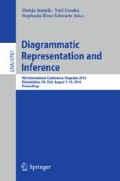Abstract
Fictional spaces described in literary texts are unique in that their spatial information is always underspecified, leaving readers with the task of filling in the unspecified details. While ways in which readers fill in unspecified elements have been proposed, very little empirical work has been done to examine the process. This paper presents an empirical study of how readers fill in unspecified details of fictional spaces described in literary texts. We asked readers to draw diagrams of the Buendía family home in the novel One Hundred Years of Solitude by Gabriel García Márquez. Diagrams were analyzed to inventory the spatial elements that were depicted across several readers. The results indicate that readers fill in the spatial details of fictional spaces using their own culturally-specific understanding of similar real world spaces, and that narrative events also assign prominence and detail to certain areas within a fictional space. Using diagrams to understand fictional spaces is discussed from a pedagogical perspective.
Access this chapter
Tax calculation will be finalised at checkout
Purchases are for personal use only
References
Busselle, R., Bilandzic, H.: Fictionality and perceived realism in experiencing stories: a model of narrative comprehension and engagement. Commun. Theory 18, 255–280 (2008)
Zoran, G.: Towards a theory of space in narrative. Poetics Today 5(2), 309–335 (1984)
McVee, M.B., Dunsmore, K., Gavelek, J.R.: Schema theory revisited. Rev. Educ. Res. 75(4), 531–566 (2005)
Zwaan, R., Langston, M., Graesser, A.: The construction of situation models in narrative comprehension: an event-indexing model. Psychol. Sci. 6(5), 292–297 (1995)
García Márquez, G.: One Hundred Years of Solitude. Harper Perennial Modern Classics, New York (1970). (Translated from the Spanish by G. Rabassa)
Rapoport, A.: The nature of the courtyard house: a conceptual analysis. TDSR 18(2), 57–72 (2007)
Wilk, R.: The built environment and consumer decisions. In: Kent, S. (ed.) Domestic Architecture and the Use of Space, pp. 34–42. Cambridge University Press, Cambridge (1990)
Author information
Authors and Affiliations
Corresponding author
Editor information
Editors and Affiliations
Rights and permissions
Copyright information
© 2016 Springer International Publishing Switzerland
About this paper
Cite this paper
Pérez-Kriz, S., Vivancos-Pérez, R.F. (2016). Using Diagrammatic Drawings to Understand Fictional Spaces: Exploring the Buendía House in Gabriel García Márquez’s One Hundred Years of Solitude . In: Jamnik, M., Uesaka, Y., Elzer Schwartz, S. (eds) Diagrammatic Representation and Inference. Diagrams 2016. Lecture Notes in Computer Science(), vol 9781. Springer, Cham. https://doi.org/10.1007/978-3-319-42333-3_14
Download citation
DOI: https://doi.org/10.1007/978-3-319-42333-3_14
Published:
Publisher Name: Springer, Cham
Print ISBN: 978-3-319-42332-6
Online ISBN: 978-3-319-42333-3
eBook Packages: Computer ScienceComputer Science (R0)

